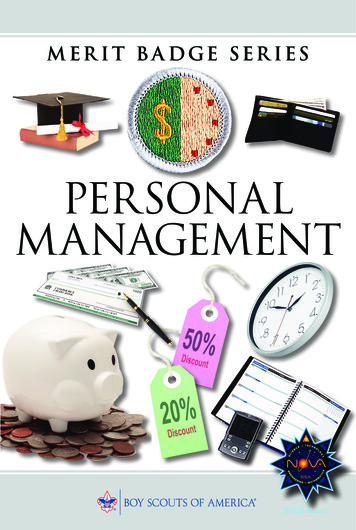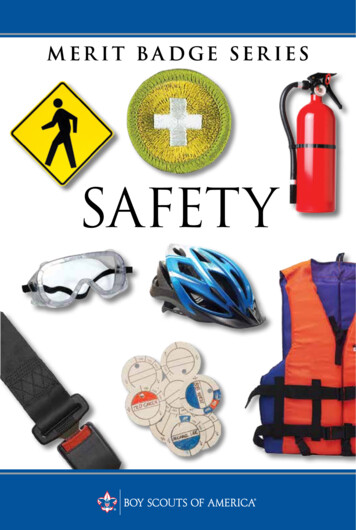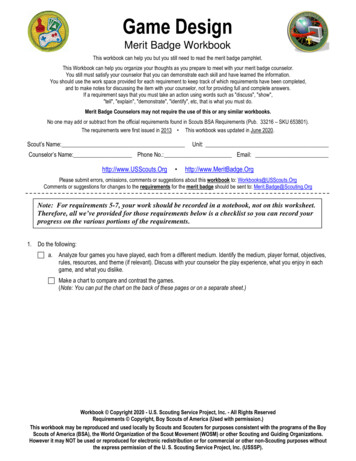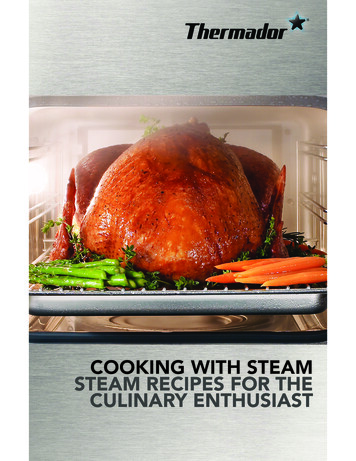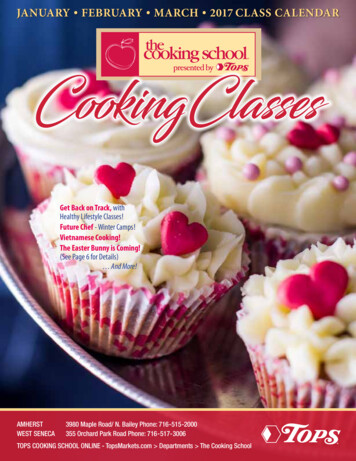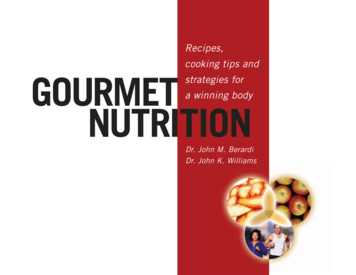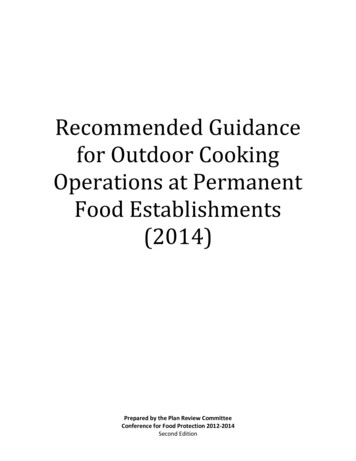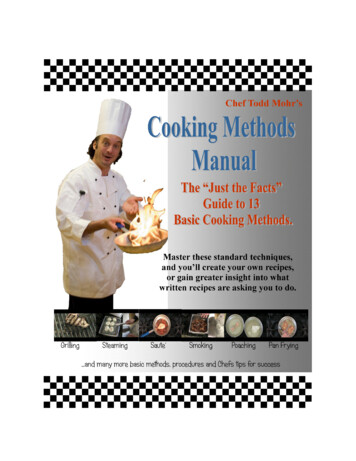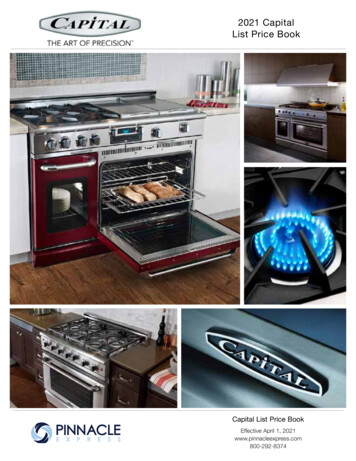
Transcription
COOKING
BOY SCOUTS OF AMERICAMERIT BADGE SERIESCOOKING“Enhancing our youths’ competitive edge through merit badges”
Requirements1. Do the following:a. Explain to your counselor the most likely hazards you mayencounter while participating in cooking activities and whatyou should do to anticipate, help prevent, mitigate, andrespond to these hazards.b. Show that you know first aid for and how to prevent injuriesor illnesses that could occur while preparing meals andeating, including burns and scalds, cuts, choking, andallergic reactions.c. Describe how meat, fish, chicken, eggs, dairy products,and fresh vegetables should be stored, transported,and properly prepared for cooking. Explain how toprevent cross-contamination.d. Describe the following food-related illnesses and tell whatyou can do to help prevent each from happening:(1) Salmonella(5) Campylobacter jejuni(2) Staphylococcal aureus(6) Hepatitis(3) Escherichia coli (E. coli)(7) Listeria monocytogenes(4) Clostridium botulinum(8) Cryptosporidium(Botulism)(9) Noroviruse. Discuss with your counselor food allergies, food intolerance,food-related diseases, and your awareness of these concerns.2. Do the following:a. Using the MyPlate food guide or the current USDA nutritionmodel, give five examples for EACH of the following foodgroups, the recommended number of daily servings, and therecommended serving size:(1) Fruits(3) Grains(5) Dairy(2) Vegetables(4) Proteinsb. Explain why you should limit your intake of oils and sugars.c. Determine your daily level of activity and your caloric needbased on your activity level. Then, based on the MyPlate foodguide, discuss with your counselor an appropriate meal planfor yourself for one day.d. Discuss your current eating habits with your counselor andwhat you can do to eat healthier, based on the MyPlatefood guide.COOKING 3
3. Do the following:a. Discuss the following food label terms: calorie, fat, saturatedfat, trans fat, cholesterol, sodium, carbohydrate, dietary fiber,sugar, protein. Explain how to calculate total carbohydratesand nutritional values for two servings, based on the servingsize specified on the label.b. Refer to “Learn How to Read the Label” in the Cooking meritbadge pamphlet, and name ingredients that help the consumer identify the following allergens: peanuts, tree nuts,milk, eggs, wheat, soy, and shellfish.4. Do the following:a. Discuss EACH of the following cooking methods. For eachone, describe the equipment needed and name at least onefood that can be cooked using that method: baking, boiling,pan frying, simmering, steaming, microwaving, and grilling.b. Discuss the benefits of using a camp stove on an outing vs. acharcoal or wood fire.c. Discuss how the Outdoor Code and no-trace principles pertainto cooking in the outdoors.Note: The meals prepared for Cooking merit badge requirements 5,6, and 7 will count only toward fulfilling those requirements andwill not count toward rank advancement. Meals prepared for rankadvancement may not count toward the Cooking merit badge. Youmust not repeat any menus for meals actually prepared or cooked inrequirements 5, 6, and 7.5. Using the MyPlate food guide or the current USDA nutritionmodel, plan a menu for three full days of meals (three breakfasts,three lunches, and three dinners) plus one dessert. Your menushould include enough to feed yourself and at least one adult,keeping in mind any special needs (such as food allergies) ofthose to be served. List the equipment and utensils needed toprepare and serve these meals. Then do the following:a. Create a shopping list for your meals showing the amount offood needed to prepare and serve each meal, and the cost foreach meal.b. Share and discuss your meal plan and shopping list withyour counselor.c. Using at least five of the seven cooking methods from requirement 4, prepare and serve yourself and at least one adult(parent, family member, guardian, or other responsible adult)one breakfast, one lunch, one dinner, and one dessert fromthe meals you planned.*4 COOKING
d. Time your cooking to have each meal ready to serve at theproper time. Have an adult verify the preparation of the mealto your counselor.e. After each meal, ask a person you served to evaluate the mealon presentation and taste, then evaluate your own meal.Discuss what you learned with your counselor, including anyadjustments that could have improved or enhanced yourmeals. Tell how better planning and preparation help ensure asuccessful meal.f. Explain how you kept foods safe and free fromcross-contamination.6. Using the MyPlate food guide or the current USDA nutritionmodel, plan a menu for your patrol (or a similar size group of upto eight youth, including you) for a camping trip. Include fivemeals AND at least one snack OR one dessert. List the equipment and utensils needed to prepare and serve these meals.Then do the following:a. Create a shopping list for your meals showing the amount offood needed to prepare and serve each meal, and the cost foreach meal.b. Share and discuss your meal plan and shopping list withyour counselor.c. In the outdoors, cook two of the meals you planned inrequirement 6 using either a lightweight stove or a low-impactfire. Use a different cooking method for each meal.** Thesame fireplace may be used for both meals. Serve this meal toyour patrol or a group of youth.d. In the outdoors, cook one of the meals you planned inrequirement 6. Use either a Dutch oven, OR a foil pack, ORkabobs. Serve this meal to your patrol or a group of youth.**e. In the outdoors, prepare a dessert OR a snack and serve it toyour patrol or a group of youth.*** The meals for requirement 5 may be prepared on different days, and they need notbe prepared consecutively. The requirement calls for Scouts to plan, prepare, andserve one breakfast, one lunch, and one dinner to at least one adult; those servedneed not be the same for all meals.** Where local regulations do not allow you to build a fire, the counselor may adjustthe requirement to meet the law. The meals in requirements 6 and 7 may be prepared for different trips and need not be prepared consecutively. Scouts workingon this badge in summer camp should take into consideration foods that can beobtained at the camp commissary.COOKING 5
f. After each meal, have those you served evaluate the meal onpresentation and taste, and then evaluate your own meal.Discuss what you learned with your counselor, including anyadjustments that could have improved or enhanced yourmeals. Tell how better planning and preparation help ensuresuccessful outdoor cooking.g. Explain how you kept foods safe and free fromcross contamination.7. Using the MyPlate food guide or the current USDA nutritionmodel, plan a menu for trail hiking or backpacking that includesone breakfast, one lunch, one dinner, and one snack. Thesemeals must not require refrigeration and are to be consumed bythree to five people (including you). List the equipment andutensils needed to prepare and serve these meals. Then dothe following:a. Create a shopping list for your meals, showing the amount offood needed to prepare and serve each meal, and the cost foreach meal.b. Share and discuss your meal plan and shopping list with yourcounselor. Your plan must include how to repackage foods foryour hike or backpacking trip to eliminate as much bulk,weight, and garbage as possible.c. While on a trail hike or backpacking trip, prepare and servetwo meals and a snack from the menu planned for requirement 7. At least one of those meals must be cooked over afire, or an approved trail stove (with proper supervision).**d. For each meal prepared in requirement 7c, use safe foodhandling practices. Explain how you kept foods safe andfree from cross-contamination. Clean up equipment,utensils, and the site thoroughly after each meal. Properlydispose of dishwater, and pack out all garbage.e. After each meal, have those you served evaluate the meal onpresentation and taste, then evaluate your own meal. Discusswhat you learned with your counselor, including any adjustments that could have improved or enhanced your meals. Tellhow better planning and preparation help ensure successfultrail hiking or backpacking meals.8. Find out about three career opportunities in cooking. Select oneand find out the education, training, and experience required forthis profession. Discuss this with your counselor, and explainwhy this profession might interest you.6 COOKING
Resources for Cooking.Resources for CookingScouting LiteratureBoy Scout Handbook; Fieldbook; BasicIllustrated Cooking Outdoors; Cookingthe Dutch Oven Way; The One PanGourmet; The Outdoor Dutch OvenCookbook; Edible Wild Plants pocketguide; Backpacking, Camping, FireSafety, First Aid, and Public Healthmerit badge pamphletsVisit the Boy Scouts of America’sofficial retail website athttp://www.scoutstuff.org.BooksConners, Tim, and Christine Conners.The Scout’s Backpacking Cookbook.Globe Pequot Press, 2012.Eddy, Jackie, and Eleanor Clark. TheAbsolute Beginner’s Cookbook: OrHow Long Do I Cook a Three-MinuteEgg?, 3rd ed. Clarkson Potter, 2002.General Mills. Betty Crocker Kids Cook!Wiley Publishing, 2007.Hodgman, Ann. One Bite Won’t KillYou. Houghton Mifflin Co., 1999.Miller, Dorcus S. Backcountry Cooking:From Pack to Plate in 10 Minutes.Mountaineers Books, 1998.New Junior Cookbook. Better Homesand Gardens, 2012.94 COOKINGSiegel, Helene, and Karen Gillingham.Totally Camping Cookbook. TenSpeed Press, 1996.PeriodicalsBefore you subscribe to a magazine,check out a copy at your local library ora nearby bookstore. Here are a few thatmay interest you: Bon Appétit, Cook’sIllustrated, Eating Well, Southern Living,Taste of Home, Vegetarian Times.Organizations and WebsitesAmerican Diabetes AssociationToll-free telephone: 800-342-2383Website: http://www.diabetes.orgAmerican Heart rgCenters for Disease Control andPreventionWebsite: http://www.cdc.govChooseMyPlateWebsite: http://www.choosemyplate.govCooking SchoolsWebsite: http://www.cooking-schools.usCulinary Institute of AmericaToll-free telephone: 800-CULINARYWebsite: http://www.ciachef.eduExploratoriumWebsite: http://www.exploratorium.edu/cooking
.Resources for CookingFood Allergy Research andEducationWebsite: http://www.foodallergy.orgFood NetworkWebsite: http://www.foodtv.comInternational Dutch Oven SocietyWebsite: http://www.idos.orgJuvenile Diabetes ResearchFoundationWebsite: http://jdrf.orgMeals.comWebsite: http://www.meals.comNational Foundation for CeliacAwarenessWebsite: http://www.celiaccentral.orgThe Recipe LinkWebsite: http://www.recipelink.comU.S. Department of AgricultureWebsite: http://www.foodsafety.govU.S. Food and Drug AdministrationToll-free telephone: 888-723-3366Website: http://www.fda.govAcknowledgmentsThe Boy Scouts of America is gratefulto Scouter and Cooking merit badgecounselor Michael Callahan,Philadelphia, Pennsylvania, a foodindustry professional, and StephanieMarcinkowski, Philadelphia,Pennsylvania, a Scouter and foodallergy awareness advocate. Theyassisted with the content for this newedition of the Cooking merit badgepamphlet. Thanks also to the U.S.Department of Agriculture’s FoodSafety and Inspection Service staff:Maribel Alonso—technical informationspecialist; Mary Harris—senior projectleader; and Nadine Shaw—food safetyspecialist, Scouter, and Cooking meritbadge counselor.We appreciate the Cleveland(Ohio) Clinic. Staff members KristinKirkpatrick, Melissa Celko-Kosmon,and James Perko were tremendouslyhelpful. Thanks also to FARE (FoodAllergy Research and Education) forits assistance.The BSA extends thanks to volunteer Scouters who helped shape thisnew edition of the pamphlet, led by BenJelsema, Clermont, Florida, with JimDePaolo, Reads Landing, Minnesota; BillPepito, Twin Lakes, Wisconsin; JimByrd, Kensington, Connecticut; DonnaCunningham, Amarillo, Texas; DavidBlack, Dallas, Texas; Walt Ritterbush,Apopka, Florida; AnnDee Sousa, Bristol,Rhode Island; and Hoang Tran,Melbourne, Florida.Some of the material provided inthis pamphlet was adapted from thewebsite of the USDA’s Center forNutrition Policy and Promotion, http://www.cnpp.usda.gov.Photo and Illustration CreditsAlex Palacios, courtesy—pages 7 and 83Shutterstock.com, courtesy—cover(pizza, Luiz Rocha/Shutterstock;wooden spoons, Chris Lenfert/Shutterstock; fish in foil, oksix/Shutterstock); pages 11 ( LindaParton/Shutterstock), 14 ( Lorenzogambaro/Shutterstock), 15 ( LuisCastro/Shutterstock), 20 and 80( Monkey Business Images/Shutterstock), 21 ( bonchan/Shutterstock), 22 ( tab62/Shutterstock), 23 (open microwave, Peter Baxter/Shutterstock; manstirring, Sergemi/Shutterstock;lasagne, mikeledray/Shutterstock),26 ( Lighttraveler/Shutterstock), 27(mint, basil, oregano, rosemary,parsley, thyme, Gts/Shutterstock;COOKING 95
Mountaineers Books, 1998. New Junior Cookbook. Better Homes and Gardens, 2012. Siegel, Helene, and Karen Gillingham. Totally Camping Cookbook. Ten Speed Press, 1996. Periodicals Before you subscribe to a magazine, check out a copy at your local library or a nearby bookstore.
